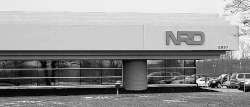Element that killed ex-Russian spy is used in products made by NRD on Grand Island
By STEPHEN T. WATSON and FRED O. WILLIAMS
News Staff Reporters
12/10/2006
 |
| Bill Wippert/Buffalo News NRD employs about 50 people in its plant on Grand Island.
|
NRD, 2937 Alt Blvd., uses polonium in its line of static-eliminating fans, brushes and other devices used in various industrial processes.
The products contain enough polonium - in theory - to yield lethal doses of the substance, according to a recent story in the New York Times.
Regulators say this scenario highlights the widespread - and little known - availability of such radioactive substances.
"Radioactive material is commonly used in lots of products," said Jeff Slawson, radiation safety officer at the University at Buffalo.
Officials at NRD and elsewhere took pains to note the radioactive material is handled safely according to stringent government regulations.
However, national security is a vital concern today as law-enforcement agents work to ensure terrorists can't get their hands on radiological, chemical or biological materials.
"As a consequence of 9/11, we're all much more in tune with potential dangers and the vigilance that's required to keep us safe in this country," said local FBI spokesman Paul Moskal.
Police in England, where Litvinenko had been living, are investigating his Nov. 23 death as a murder and are trying to trace the origin of the polonium.
But regulators say that exotic-sounding radioactive elements such as polonium are more common than one may think.
Across New York State about 1,000 companies, doctors' offices and university labs are licensed to use low-level radiation emitters such as polonium or americium, the substance inside smoke detectors, according to the state Health Department.
A department spokesman declined to list the licensees, citing security concerns.
Polonium exists naturally in tiny quantities in our bodies, and in small amounts in the air and soil, according to the Health Physics Society, a group that supplies information on radiation safety.
Polonium's weak "alpha" form of radiation can be stopped by a sheet of paper or the outermost layer of skin, making it harmless unless ingested. "External exposure is not an issue," said David McIntyre, public affairs officer at the U.S. Nuclear Regulatory Commission.
NRD, a 50-employee company that opened in 1969, calls itself one of the world's largest producers of anti-static devices, some of which use the element Polonium-210. It is owned by Mark IV Industries, which is headquartered in Amherst and in Italy and has operations in 16 countries.
"Alpha" anti-static products take advantage of the rapid decay rate of polonium - which loses half its radioactivity every 138 days - to emit ions that neutralize static.
A static charge in the air can harm computer parts and camera lenses and disrupt factory processes, especially in electronics manufacturing.
NRD also produces the radioactive components used in smoke detectors and glow-in-the-dark exit signs.
Grand Island Supervisor Peter A. McMahon said he and other town officials met with NRD officials after the Sept. 11, 2001, terror attacks to go over the company's safety precautions. The company also works closely with the Grand Island Fire Department to prepare the best possible response to any fire or other problem at the facility.
"There's a long-standing relationship with the community," McMahon said.
NRD President Douglas Fiegel said he's been barraged with media calls since a Times article last Sunday suggested that his company's products, or similar ones, could have been used as a source of radioactive poison.
Fiegel refused to comment beyond a written statement, which states that NRD is licensed to use radioactive Polonium-210 and its sealed products "have undergone rigorous testing and safety analysis."
UB's Slawson noted that radioactive material is used in diagnosing diseases and in other medical applications.
Scientists in UB's Medical School, Dental School and other units conduct research involving radioactive substances.
The purchase, use and storage of radioactive materials is closely regulated, Slawson said, and anyone handling those substances receives safety training.
Commercial distributors of polonium-containing products must file quarterly reports disclosing their sales and buyers, said McIntyre of the Nuclear Regulatory Commission.
Facilities in Erie County that use, store or manufacture hazardous substances - including radioactive, nuclear, chemical and explosive materials - must register annually with the county's Emergency Services Department, said Dean A. Messing, county emergency operations supervisor.
There are 203 such facilities in Erie County, Messing said.
What about the prospect that someone could have ordered an anti-static fan and extracted more than enough polonium to kill Litvinenko, the former Russian spy?
NRD's Fiegel wouldn't comment. But the Nuclear Regulatory Commission spokesman called the idea far-fetched.
"We think it would be extremely difficult for someone to do that," McIntyre said. Like the radioactive americium in smoke detectors, polonium used in anti-static products is electroplated with gold, encapsulating it.
To make the polonium deadly would require a lab process to release it from its metal capsule, allowing it to be absorbed by the body.
"You would have to know how to extract polonium - there are a lot of other things out there that can be used to poison people," McIntyre said.